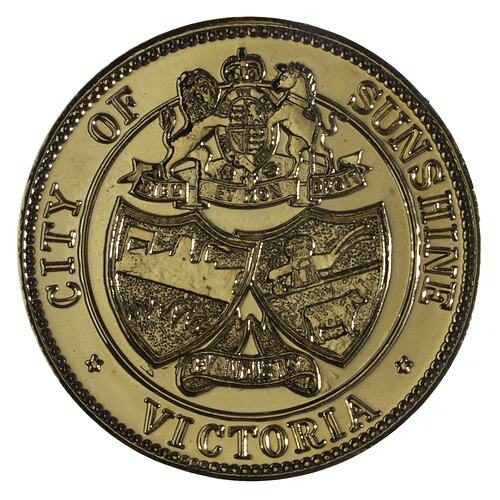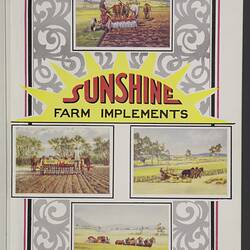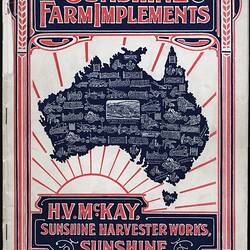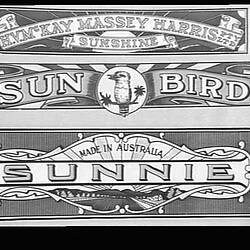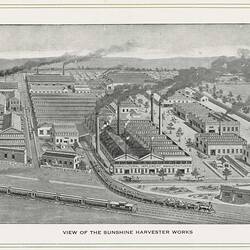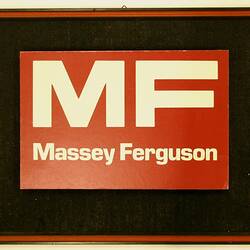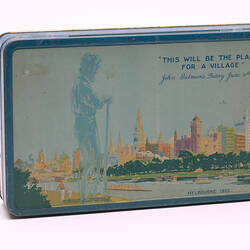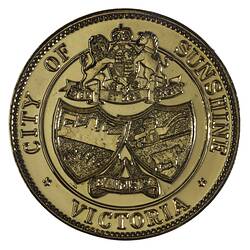For thousands of years before European settlement, the Wurundjeri people lived on the plains where Sunshine and its surrounding suburbs now sprawl. Their traditional way of life was decimated by European settlers, but material evidence of this once-thriving community can still be seen in the remains of camping grounds - the tools and cooking sites - and trees cut away to build canoes. There are 184 significant Aboriginal sites recorded in the area.
Charles Grimes was probably the first European to see the Sunshine area. He explored the fringes of Port Phillip Bay in February 1803 and noted the sweeping plains, distant mountains and two salty watercourses - later called Kororoit Creek and Skeleton Creek. After the Port Phillip Association led by John Batman established a European settlement on the headwaters of Port Phillip Bay, pastoralists soon pushed out over the plains to the north-west, with two vast sheep stations being established in the area now known as Sunshine by men named Cotterell and Solomon.
Other early settlers to the area included William and Catherine Prendergast, Irish immigrants who arrived in 1841. By the late 1840s they were working for Joseph Raleigh, a wealthy merchantman and grazier who had started out operating a punt on the Saltwater (later Maribyrnong) River, near the present day Raleigh Street Bridge. He established a boiling-down works for the production of tallow when the livestock market collapsed in 1843, and went on to establish a meat preserving works on the river bank, overlooked by a castle-like bluestone structure built to accommodate shepherds and workers. The cannery grew to become the largest meat processing works in the nation before it closed in 1886 (owing to competition from the new technology of refrigeration and frozen meat exports).
By 1850, the settlement of Braybrook was well established. As the goldrushes began, the area became a staging point for prospectors on their way to the diggings. A blacksmith's shop was established in 1854, and in 1856 a school was opened for the area's children. During the following two decades the district became renowned for its racehorses, with some of the country's finest thoroughbreds being raised at the Maribyrnong Estate stud farm.
On 28th May 1860, the Braybrook District Road Board was incorporated, providing the first municipal government for the area, and it was subsequently replaced by the Shire of Braybrook, proclaimed on 27th May 1871. The 1861 Census recorded 463 people living in the townships of Maidstone, Albion and Braybrook, but the population soon grew as bluestone quarries, chaffmills and other industries developed along the main railway line to Bendigo and the Murray River (at Echuca), which ran through the shire.
In 1884, the Victorian Railways began construction of a branch line from the Bendigo line, heading westwards towards Melton, Bacchus Marsh and Ballarat, where in 1889 it was connected to the original railway Geelong-Ballarat Railway at Ballarat East. A railway station called Braybrook Junction opened on 7th September 1885, just south of the point where the Bendigo and Ballarat lines diverged. New industries where established around the railway junction, including the Australian Lithofracteur Co. (1881), for the manufacture of nitro-glycerine explosives, the Braybrook Implement Works (1888), established by the Mellor Bros of South Australia to manufacture stump-jump ploughs and other agricultural implements for Victorian farmers, and Wright & Edwards Carriage Works (1889), to manufacture goods wagons and carriages for the Victorian Railways.
By 1891, nearly 1,000 men were working in factories & quarries around Braybrook, but only about 50 tradesmen and their families were living near the Junction, with the rest commuting to the area daily by train. Although the financial recession of 1891 brought about the premature closure of Wright & Edwards Carriage Works, other industries soon replaced it, including the Phoenix Fireworks Co., just north of Ballarat Road, Danks & Barnes Smelting & Ore Treatment Works (1894), and Edmund Parsons Horsehair Factory (1900), near Kororoit Creek.
When a severe Australia-wide drought in 1902 saw the Braybrook Implement Co. Ltd forced into liquidation, the future of Braybrook looked set to receive another setback, but the idle factory was bought by Hugh Victor McKay in 1904 and reopened. McKay had conceived a revolutionary stripper harvester in the 1880s, which from 1894 was marketed as the 'Sunshine Harvester', and by the late 1890s he was operating a sizable manufacturing works at Ballarat producing his harvesters and related products. In 1906, McKay made the decision to relocate his entire manufacturing enterprise to Braybrook Junction, and the former Braybrook Implement Works became the nucleus of the vast Sunshine Harvester Works, which within six years employed 1,300 people. By the 1920s it was claimed to be the largest manufacturing plant in the southern hemisphere. McKay purchased some 300 acres of rural land near the factory site and developed a residential estate to house his workers.
McKay's impact in transforming the fortunes of the Braybrook district were so dramatic that in May 1907, after receiving a petition from 100 residents, the Shire Council voted to urge the Railway and Postal Departments to officially change the name of the suburb from Braybrook Junction to Sunshine. The Railway Commissioners agreed to the change of name in July 1907.[4,5]
In October 1907, the new suburb of Sunshine made national headlines when Justice Higgins of the Industrial Arbitration Court presented his historic judgement in response to a hearing on H.V. McKay's application for exemption from the Excise Tariff on harvesters. His decision, subsequently known as simply the "Harvester Judgement", defined for the first time in Australia what was a "fair wage" for manufacturing workers - set at seven shillings per eight-hour day for unskilled labourers. The judgement set the standard for industrial wage regulation and minimum wages throughout Australia, changing the face of relationships between workers and employers across the nation. It also reinforced Sunshine's position as the heart of the nation's industrial growth.
Sunshine again made national news headlines the following year, when on Easter Monday 20th April 1908, two passenger trains crowded with holiday makers returning from Bendigo and Ballarat collided just south of the railway junction, causing the death of 44 passengers and injuries to 400 others. It remains Australia's second worse railway disaster.
The Depression of the early 1930s would check the expansion of the Sunshine Harvester Works as demand for agricultural equipment declined and many workers were laid off, but demand had revived by the late 1930s, and during the Second World War, the Harvester Works were operating at full capacity making agricultural equipment for Australian and British farmers as well as munitions, tank parts, rifles and vehicles for the war effort.
Other manufacturers also became established in Sunshine during the early 20th century, including Spaldings, Crittalls, Darling's Flour Mill, Sunshine Potteries, Pridham, Pennells and Nettlefolds. As early as 1922, the Maribyrnong River Anti-pollution committee was lobbying the State Government to control the spread of fumes from Braybrook.
In the post-war years migrants swelled the local population to 20,000, and the municipality was proclaimed The City of Sunshine on 16 May 1951. Today these residents represent more than 156 nationalities, one of the most cosmopolitan communities in Australia [6]. The Sunshine library today holds collections in 16 languages.
In 1985, the City of Sunshine issued a medal (NU 20682) to commemorate Victoria's sesquicentenary and shortly afterwards the Sunshine Harvester Works closed its gates for the last time, with the former factory site being cleared to make way for a carpark, community centre and shopping mall.
On 15 December 1994, under wide scale municipal changes initiated by the Kennett Liberal State Government, the cities of Sunshine and Keilor were amalgamated to form the new City of Brimbank. This became the second largest municipality in Melbourne and the largest in the Western Region of Melbourne. [6]
The former Sunshine City Hall in Alexandra Avenue, Sunshine, became municipal offices for the City of Brimbank.
References:
1. Alastair Rosie, http://home.iprimus.com.au/asrosie/localtraders.pdf
2. Australian places website, Monash University, http://www.arts.monash.edu.au/ncas/multimedia/gazetteer/list/maribyrnong.html.
3. VICNET web site (unit of the State Library of Victoria), http://home.vicnet.net.au/~sunshine/sunshine.htm.
4. The Argus, 14 May 1907, p.6, http://nla.gov.au/nla.news-article10634890, accessed 06/10/2011.
5. The Argus, 10 Jul 1907, p.5, http://nla.gov.au/nla.news-article10134882, accessed 06/10/2011.
6. Brimbank City Coucil, http://www.brimbank.vic.gov.au/COUNCIL/About_Brimbank, accessed 30/06/2014.
More Information
-
Keywords
-
Localities
-
Authors
-
Article types
